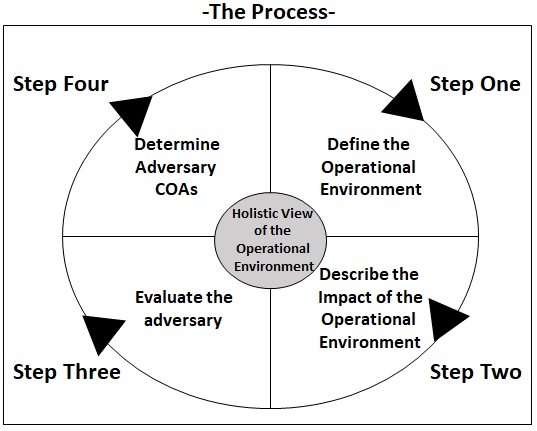Joint Intelligence Preparation of the Operational Environment (JIPOE) is the analytical process used by joint intelligence organizations to produce intelligence assessments, estimates, and other intelligence products in support of the commander’s decision-making process. It is a continuous process that involves four major steps: (1) defining the total operational environment; (2) describing the impact of the operational environment; (3) evaluating the adversary; and (4) determining and describing adversary potential courses of action (COAs), particularly the adversary’s most likely COA and the COA most dangerous to friendly forces and mission accomplishment.

JIPOE supports joint planning by identifying significant facts and assumptions about the operational environment. This information includes details regarding adversary critical vulnerabilities, capabilities, decisive points, limitations, COGs, and potential COAs.
The process is used to analyze the physical domains (air, land, maritime and space); the information environment (which includes cyberspace), political, military, economic, social, information, and infrastructure (PMESII) systems; and all other relevant aspects of the operational environment, and to determine an adversary’s capabilities to operate within that environment. JIPOE products are used by joint force, component, and supporting command staffs in preparing their estimates and are also applied during the analysis and selection of friendly COAs.
JIPOE is a continuous process which enables CDRs and their staffs to visualize the full spectrum of adversary capabilities and potential COAs across all dimensions of the operational environment. JIPOE is a process that assists analysts to identify facts and assumptions about the operational environment and the adversary. This facilitates campaign planning and the development of friendly COAs by the joint force staff. JIPOE provides the basis for intelligence direction and synchronization that supports the COA selected by the CDR. JIPOE’s main focus is on providing situational awareness and understanding of the operational environment and a predicative intelligence estimate designed to help the CDR discern the adversary’s probable intent and most likely and most dangerous COA.
JIPOE Consists of Four Major Steps:
Step 1 — Define the Operational Environment
During Step 1, the joint force staff assists the JFC and component CDRs in determining the dimensions of the joint force’s operational environment by identifying the significant characteristics of the operational environment and gathering information relating to the operational environment and the adversary.
Step 2 — Describe the Impact of the Operational Environment
Step 2, describing the operational environment impacts, focuses on the environment. The first action in describing operational environment effects is to analyze the military aspects of the terrain. The acronym that aids in addressing the various aspects of the operational environment is OCOKA – Observation and Fields of Fire, Concealment and Cover, Obstacles, Key Terrain, and Avenues of Approach. This analysis is followed by an evaluation of how these aspects of the operational environment will affect operations for both friendly and adversary forces. Products developed during this step might include overlays and matrices that depict the military effects of geography, meteorological (METOC) factors, demographics, and the electromagnetic and cyberspace environments. The primary product from JIPOE produced in Step 2 is the Modified Combined Operations Overlay (MCOO)
Step 3 — Evaluate the Adversary
Step three of the JIPOE process, evaluating the adversary, identifies and evaluates the adversary’s military and relevant civil center of gravity (COG), critical vulnerabilities (CVs), capabilities, limitations, and the doctrine and Tactics, Techniques and Procedures (TTPs) employed by adversary forces, absent any constraints that may be imposed by the operational environment described in step two.
Step 4 — Determine Adversary Courses of Action (COAs)
The first three steps of the JIPOE process help to satisfy the operational environment awareness requirements of the CDR and subordinate CDRs by analyzing the effects of the battlespace environment, assessing adversary doctrine and capabilities, and identifying adversary COGs. The fourth step of the JIPOE process seeks to go beyond operational environment awareness to help the CDR attain knowledge of the operational environment (i.e., a detailed understanding of the adversary’s probable intent and future strategy). The process for Step four provides a disciplined methodology for analyzing the set of potential adversary COAs in order to identify the COA the adversary is most likely to adopt, and the COA that would be most dangerous to the friendly force or to mission accomplishment.
 This article is an extract from "Joint/Interagency SMARTbook 1 – Joint Strategic & Operational Planning, 3rd Ed. (Planning for Planners (JIA1-3 / Third Edition))" by The Lightning Press. Download a free PDF sample and learn more at: Joint/Interagency SMARTbook 1 – Joint Strategic & Operational Planning, 3rd Ed. (Planning for Planners (JIA1-3 / Third Edition)).
This article is an extract from "Joint/Interagency SMARTbook 1 – Joint Strategic & Operational Planning, 3rd Ed. (Planning for Planners (JIA1-3 / Third Edition))" by The Lightning Press. Download a free PDF sample and learn more at: Joint/Interagency SMARTbook 1 – Joint Strategic & Operational Planning, 3rd Ed. (Planning for Planners (JIA1-3 / Third Edition)).
Browse additional military doctrine articles in our SMARTnews Blog & Resource Center.
About The Lightning Press SMARTbooks. Recognized as a “whole of government” doctrinal reference standard by military, national security and government professionals around the world, SMARTbooks comprise a comprehensive professional library. SMARTbooks can be used as quick reference guides during operations, as study guides at education and professional development courses, and as lesson plans and checklists in support of training. Browse our collection of Military Reference SMARTbooks to learn more.













































